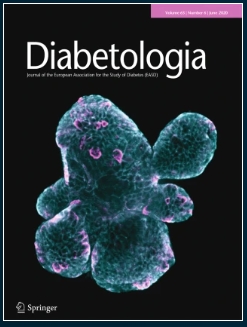在瑞典一项基于人群的匹配队列研究中,2007年至2023年1型糖尿病发病率趋势及其与SARS-CoV-2感染的关系
IF 10.2
1区 医学
Q1 ENDOCRINOLOGY & METABOLISM
引用次数: 0
摘要
目的/假设在流感大流行期间,各国1型糖尿病的发病率有所增加。SARS-CoV-2感染可能引发1型糖尿病的发展,但证据尚无定论。本研究旨在评估2007年至2023年间1型糖尿病发病率的趋势,并量化SARS-CoV-2感染与患1型糖尿病风险之间的关系。方法本研究包括所有在瑞典登记的30岁以下的个体。使用泊松回归评估了每个大流行年(2020-2023年)1型糖尿病发病率与大流行前趋势(2007-2019年)的偏差。采用Cox比例风险模型评估SARS-CoV-2感染的影响,该队列由感染个体和5名对照个体组成,从病例感染日期开始,按出生年份、性别和地区进行匹配。结果与预测的线性趋势相比,2021年1型糖尿病发病率增加了12%(发病率比[IRR] 1.12; 95% CI 1.06, 1.19), 2022年增加了9% (IRR 1.09; 95% CI 1.02, 1.16),但在2023年恢复到大流行前的趋势。总体而言,SARS-CoV-2感染后发生1型糖尿病的校正风险比为0.96 (95% CI 0.79, 1.16)。5至10岁的儿童在感染后的前28天内更有可能发展为1型糖尿病(HR 2.68; 95% CI 1.22, 5.89),尽管他们在整个随访期间的风险没有增加。结论/解释:瑞典在其非限制性大流行应对中,1型糖尿病发病率短暂增加,这与SARS-CoV-2感染仅部分相关。应该调查其他解释,包括环境和生活方式因素。本文章由计算机程序翻译,如有差异,请以英文原文为准。
Trends in type 1 diabetes incidence between 2007 and 2023 and their association with SARS-CoV-2 infection in a population-based matched cohort study among individuals under 30 years old in Sweden.
AIMS/HYPOTHESIS
The incidence of type 1 diabetes increased during the pandemic in various countries. SARS-CoV-2 infections may trigger the development of type 1 diabetes, but the evidence is inconclusive. This study aimed to assess trends in type 1 diabetes incidence between 2007 and 2023, and to quantify the association between SARS-CoV-2 infections and the risk for developing type 1 diabetes.
METHODS
The study included all individuals under 30 years old registered in Sweden. Deviations in type 1 diabetes incidence from pre-pandemic trends (2007-2019) were assessed for each pandemic year (2020-2023) using Poisson regression. The effect of SARS-CoV-2 infections was assessed using Cox proportional hazards models in a cohort of infected individuals with five control individuals from the infection date of the case, matched by birth year, sex and region.
RESULTS
Compared with the predicted linear trend, type 1 diabetes incidence increased by 12% during 2021 (incidence rate ratio [IRR] 1.12; 95% CI 1.06, 1.19) and 9% during 2022 (IRR 1.09; 95% CI 1.02, 1.16), but reverted to pre-pandemic trends in 2023. Overall, the adjusted HR for developing type 1 diabetes after SARS-CoV-2 infection was 0.96 (95% CI 0.79, 1.16). Children between 5 and 10 years old were more likely to develop type 1 diabetes within the first 28 days after infection (HR 2.68; 95% CI 1.22, 5.89), although their hazard over the whole follow-up period was not increased.
CONCLUSIONS/INTERPRETATION
Sweden, with its non-restrictive pandemic response, saw a transient increase in type 1 diabetes incidence that was only partially associated with SARS-CoV-2 infections. Other explanations should be investigated, including environmental and lifestyle factors.
求助全文
通过发布文献求助,成功后即可免费获取论文全文。
去求助
来源期刊

Diabetologia
医学-内分泌学与代谢
CiteScore
18.10
自引率
2.40%
发文量
193
审稿时长
1 months
期刊介绍:
Diabetologia, the authoritative journal dedicated to diabetes research, holds high visibility through society membership, libraries, and social media. As the official journal of the European Association for the Study of Diabetes, it is ranked in the top quartile of the 2019 JCR Impact Factors in the Endocrinology & Metabolism category. The journal boasts dedicated and expert editorial teams committed to supporting authors throughout the peer review process.
 求助内容:
求助内容: 应助结果提醒方式:
应助结果提醒方式:


